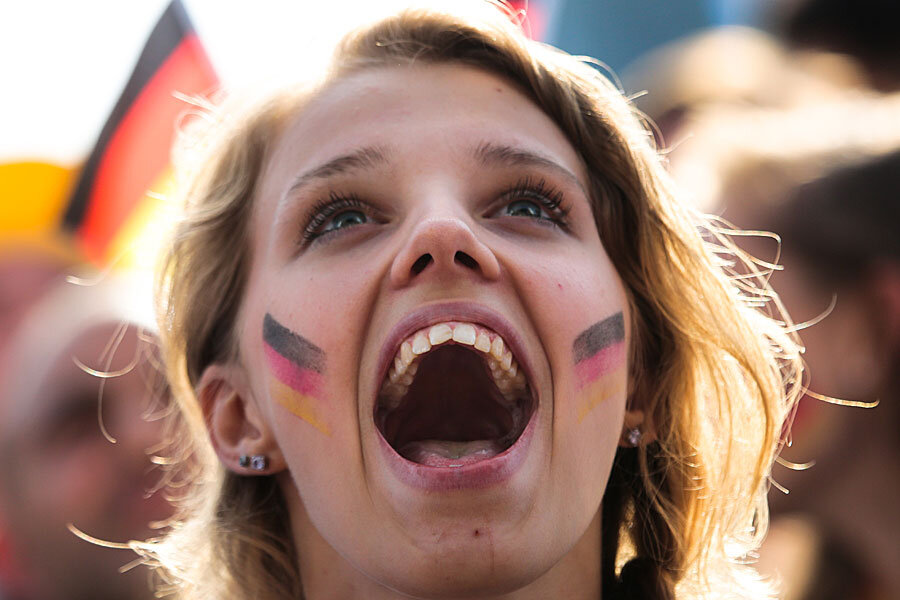World Cup 2014: Why are there so many goals?
Loading...
Somewhere in Brazil, even Spanish sportscaster Andrés Cantor may be tiring of his signature scoring bellow.
Not since 1958, have there been this many goals this early in the World Cup. Through Monday's matches, there were 44 goals in 14 games.
That's an average of just over 3.1 goals per game. It took 13 matches before we saw a single tie, and that was a nil-nil score Monday (Iran vs. Nigeria).
By comparison, at this point in the 2010 World Cup, teams in South Africa were scoring an average of just one goal per game.
What's going on?
As fitting a sport bestriding the global stage, there are almost as many theories as nations competing. It could be the warm climate. Or, perhaps the aerodynamics of the World Cup 2014 ball, the Brazuca. Often, the ball (remember South Africa's Jabulani ball) is a source of real or imagined controversy. But this year, there's been nary an orb naysayer.
Surely, there must be something more fundamental afoot.
An argument can be made that offense, or at least a style of offense that exhibits a more flexible tactical approach, may be behind the 2014 World Cup surge in scoring.
Certainly, strong defensive play has often marked the winners of past World Cups. That's partly because many coaches have figured that it was easier to pull together disparate players (with a short amount of time) into a cohesive national defensive unit than to build a fluid and effective attacking team. The Italians perfected a defensive system decades ago, and even today any defense-oriented strategy is often short-handed as the Catenaccio approach, which means "bolted door."
But watching the first five days of World Cup 2014, a case can be made that the Age of the Bolted Door is over. The power of a flexible attack is winning converts.
Exhibit A: Germany's 4-0 victory over Portugal Monday.
Germany's coach Joachim "Jogi" Löw has carried on the transformation of the German national team that began under the current Team USA coach Jürgen Klinsmann in 2004. The two were a powerful force for change as they took the three-time world champions from a static and defensive style to a team focused on a fluid attack. Germany rode the emphasis on an attacking style to a third place finish in the 2006 World Cup, and effectively quelled most German critics of this shift.
Klinsman left the job after 2006, and Löw – often considered the tactical genius of the two – became the coach and has continued to develop the approach. One of Löw's cornerstones is ball movement. He has emphasized reducing that time a player holds a ball, and thus increasing the overall tempo of the German game. Fans of the NBA's San Antonio Spurs will recognize and appreciate the value of team ball movement.
In soccer, the formations also tell a story. And for Klinsmann and Löw, the formations have been both offensively-oriented and flexible. And the players selected for the national team are versatile and technical attacking players.
For example, Germany under Löw has often employed a 4-2-3-1 formation. At a press conference last year, Löw outlined some of his thinking, according Cristian Nyari at BundesligaFanatic.com:
The idea is to have a more mobile and interchangeable front four that doesn’t rely on direct patterns of play or predictable lines of passing. Where before one might see central midfielders looking to play the ball out wide before sending a cross inside, Götze [the attacking midfielder] will pull defenders with him and either the right, left or central attackers take the vacated space and vice versa. The roles are less rigid and more open to interpretation. Theoretically, it should serves to unsettle defensively organized sides and make full use of all the technically capable and quick players Germany has available.
But due to injuries, against Portugal on Monday, Löw went to a 4-3-3 formation, which has been his fall back formation in recent years. As Nyari, who also writes for Bleacher Report, put it:
Low abandoned the use of a traditional striker altogether and deployed an interchangeable front three, one of which was Mesut Ozil. To truly get the best out of Germany's many talented attackers, he needed to make space up front and provide them a platform on which to truly express themselves.
In Mario Gotze, Ozil, Muller, Andre Schurrle and Lukas Podolski, Germany have players that can both score and create. There is no reason to tie them down to separate roles. Rather, a degree of freedom within a disciplined yet rotating system suits them best as the Portugal game proved.
Of course, Germany isn't the only team with a greater focus on offense at this World Cup.
England, notes Adam Bate at Sky Sport, is adopting more of an attacking mentality. While England came up short against Italy over the weekend, "England’s ambition appears to have formed part of a wider narrative. Chile were notably different in South Africa due to their willingness to commit men forwards and were similarly ambitious in their game against Australia."
Bates continues: "However, it now seems to be the more staid approach of Greece that is the exception to the rule. Their conservative game plan saw them finish goalless against Colombia – one of only three teams to fail to find the net in the first 11 matches of the tournament. Ancient Greek relics."
Bates also adds a few more theories as to why this World Cup has had such high-scoring early matches, including poor goalkeeping and a more variety in formations. "The ubiquity of 4-2-3-1 four years ago has become more nuanced with a variety of formations creating interesting clashes. Spaces and overloads lead to goals," he writes.
Over at The Telegraph, Jonathan Liew picks up on the same theme, but adds some stats about more passing. Echoes of Löw's philosophy?
This time, 4-2-3-1 may still be the dominant force, but other styles are beginning to evolve. The United States under Jurgen Klinsmann play a midfield diamond. Louis van Gaal played a reactive, counter-punching 3-4-3 against Spain. Honduras even play 4-4-2, bless their little hemp socks. In fact, a lot of the smaller countries have gone with a variant of the two-striker system, from Ecuador to Chile to Nigeria.
How is this playing out on the pitch? More direct football – possibly as a result of the climatic conditions, which we’ll come to later – and more incisive passing. We asked Opta for the average number of passes leading to a goal in this World Cup compared to the last. The results are interesting.
Average passes leading to goal
2010 2.91
2014 2.63Which suggests that teams are trying to move the ball forward quicker. That doesn’t necessarily mean long ball – the percentage of long balls is actually down on this World Cup so far – but it might indicate that teams are playing more effective key passes, or perhaps winning the ball higher up the pitch.
Liew also notes that in the big four European leagues – the Premier League, La Liga, Serie A and the Bundesliga, goals per game are on the rise, too.
"We live in a glorious age of attackers – Messi, Ronaldo, Suarez, Ibrahimovic, Cavani, Bale, Aguero, Robben, Ribery, Falcao, Van Persie, Neymar – and yet genuinely great defenders are thin on the ground."








